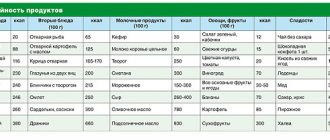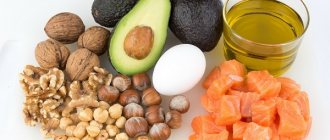Why did this problem occur?
There are several reasons.
- A lot of ready-made, processed foods have appeared in our diet.
- Sweet carbonated water and delicious desserts have become the norm.
- Working at a computer, lack of physical housework thanks to modern household appliances, traveling by car. Technological progress has given us comfort and extra weight as a bonus.
Now we have to do something with this “bonus”.
Have you decided to lose weight? Congratulations. The first step has already been taken. There is intention, but it is not enough.
Weight loss occurs when a person expends more energy than he consumes. This is called a negative energy balance. The body uses up energy reserves, starting with fat, to make up for the deficiency.
But it is worth considering that a person with a small amount of fat will spend more muscle tissue. This can lead to further health problems, including:
- high risk of osteoporosis
- decrease in muscle mass
- problems regulating body temperature
- weakened immune system
The principle of losing weight by burning calories
It is a well-known fact: to lose weight, your calorie expenditure per day must exceed the amount of energy consumed. This can be achieved in three ways:
- Reducing calorie intake without changing your daily routine.
- Increasing your activity level without changing your diet.
- Reduce caloric intake and increase physical activity.
For example, if a person spends on average 1700 Kcal per day and eats 2400 Kcal, then he will inevitably gain weight. The situation can be changed by reducing the calorie content of the diet to 1400–1500 Kcal, and energy consumption must be increased by at least 200–300 Kcal. Calculating the results is simple, but how do we know how much energy we spend? How much volume should you burn to get rid of the hated kilograms and how to do it without nerves and harm to your health?
Calorie consumption during training
How many calories should you burn to lose weight?
A calorie is a unit of energy measurement. Calories are commonly used to measure the energy content of foods and drinks.
For good mental and physical well-being, a woman needs to consume about 2000 calories per day. The figure is relative. Since a lot depends on physical activity. But the body will successfully spend these calories, even if you lie on the sofa.
To do this, you need to calculate the calorie deficit taking into account the characteristics of the body and adjust the menu. The typical formula that says that in order to lose weight you must burn more calories than you consume does not take many factors into account. For example, how the composition of those calories affects the body - from blood sugar levels to insulin levels, digestive changes and hunger hormones.
How many calories do you need per day to lose weight? Nutritionists have calculated that if you consume 2000 calories a day and burn 2500, you can lose one kilogram in two weeks.
In this case, the calorie deficit will be 500 kcal.
And at first it will really give results.
But everything is not so simple in our body.
How many calories do you burn during sex?
Sex is, of course, not a full-fledged workout, but it provides powerful physical stress to the body, and this can be used for weight loss . Here's what experts say about this method of burning calories:
- One kiss destroys 68 kcal, but only if it lasts 60 minutes. If a woman kisses her beloved man in a position on top and simultaneously performs push-ups, then she will be able to get rid of 70 kcal in 10 minutes.
- Undressing each other burns about 8 kcal. If a man begins to unfasten his beloved’s bra with his teeth, he will burn about 50 kcal in 1-3 minutes!
- The massage will be pleasant for both partners. In an hour of such pleasure you can burn 80 kcal. Both the massage therapist and the person receiving the “service” will have the same result.
- 30 minutes of slow, erotic dance, even in clothes, and you can get rid of 100 kcal. The pace may vary, but it is better if it starts to gradually accelerate.
- An hour of active sex - and 145 kcal will be burned. If the woman is in the position on top, then you can safely add another 50 kcal to this indicator.
If you count all of the above, then in half an hour of full-fledged sex with foreplay and “games” you can lose almost 400 kcal . This is equivalent to 100 g of chocolates and 50 g of sweet paste.
We recommend reading the article about treadmill running for weight loss. From it you will learn about the benefits of running, choosing a treadmill, features of interval running, first results and contraindications to exercise. And here is more information about Nordic walking for weight loss.
You can burn calories in various ways. The most pleasant thing is sex with your loved one, but it will not give impressive results. Therefore, it is better to combine “carnal pleasures” with banal physical activity and lose weight smoothly, while maintaining muscle mass.
Rate of weight loss
The body actually actively burns accumulated fat during an artificial calorie deficit. But he has this peculiarity - to adapt to circumstances.
Under conditions of malnutrition, the body begins to conserve energy, and therefore metabolism will certainly slow down. And if the first weeks may please us with minus kilograms on the scales, do not flatter yourself - this will not last long.
What will help boost your metabolism again? Of course, physical activity.
A 2010 study on monkeys found that those who simply reduced their daily caloric intake rarely lost much weight.
This happens because the body's natural compensatory mechanisms reduce physical activity. The body slows down and becomes weaker, it experiences stress and, instead of losing weight, it begins to accumulate fat, storing it away for better times. Therefore, the diet must be combined with physical activity.
How many calories per hour does it take to train?
How many calories do you need to burn per workout to get the weight loss effect? There are different types of exercises and physical activity. For example, with interval training, up to 900 kcal are consumed per hour of training. Moreover, even after 15 minutes of exercise, the body will use fat reserves to recover if the person’s nutrition is correct.
How many calories are burned when climbing stairs?
Cardio training burns from 500 to 800 kcal. It’s just important to remember that you need to exercise for at least an hour, since fat reserves will begin to melt only after 20 or 30 minutes of exercise. Endurance plays a big role here.
Important! The more resilient your body is, the more fat you can burn.
Power loads
Metabolism consumes calories constantly: during training, when processing food in the gastrointestinal tract, and even during sleep and rest. To burn enough calories for weight loss, you need to exercise 3-5 times a week, as well as regularly take walks in the fresh air, take the stairs instead of the elevator, etc.
Why is physical activity so important for losing weight?
- Speed up metabolism.
- Saturate the body with oxygen.
- Prevents muscle loss during weight loss.
In the process of losing weight, we dream of getting rid of excess fat, but along with it we also lose muscle mass. Which negatively affects the beauty of the body. In previous articles, we have repeatedly talked about an integrated approach to losing weight, the importance of strength and aerobic exercises for maintaining muscle texture, for correcting your figure after losing weight.
It is unlikely that losing 5 kilograms will bring you joy if the skin on your stomach, arms or thighs sag. Of course, this happens, so we have prepared a separate article for you on how to tighten your skin after losing weight, but to minimize the negative consequences, we recommend losing weight by engaging in active training.
How many calories can you burn in one gym workout?
Classes in the gym are always intense, so you burn calories faster. During an intense workout, you can burn 7-9 Kcal per minute, and if the session lasts 60 minutes, then the person losing weight gets rid of 500-600 Kcal. But these data are not accurate, because a lot depends on what kind of sport a person is involved in:
- While performing exercises with a gymnastic ball, you can get rid of 200 kcal in 1 hour. Typically, such a load is gentle, the pace of the exercise is low or average, so the rate of calorie burning will also not be very impressive.
- Zumba is a specific workout that resembles a fast dance or a set of aerobics exercises . You shouldn’t expect excellent results, but burning 300 kcal in an hour of active exercise is quite possible.
Zumba movements
- General complex. We are talking about a full-fledged workout in the gym, during which gymnastics, exercises on standard machines, and strength training are given. In 60 minutes you can burn about 600 kcal. It doesn’t matter at all what speed the exercises are performed, the end result remains the same.
- Tabata is a short-term workout that lasts only 4 minutes , but during this time strength exercises are performed at a very fast pace. In 1 minute of such a load, almost 14 kcal are burned! If you perform 3-4 approaches to Tabata per day, then it is not difficult to calculate the number of calories that you will be able to get rid of - 250 kcal minimum, which is not bad at all, considering the amount of time to complete the complex.
Calorie calculation for weight loss
It is not only the quantity of calories consumed that is important, but also their quality
The ability to determine how many calories are burned each day is essential for anyone who wants to maintain, lose or gain weight.
Knowing what factors contribute to calorie burning can help you change your diet or exercise program to achieve your goal.
It should be recalled once again that the body should not experience stress when losing weight. You need to know the minimum safe amount of calories for your body. There is a fairly accurate calculation formula that will help determine the daily calorie intake at rest, we will offer one of them.
Initial data:
- Weight, kg)
- Height (cm)
- Age (years)
Have you weighed yourself? Have you measured it? Have you looked at your passport? Then we count.
9.99 x weight (kg) + 6.25 x height (cm) – 4.92 x age (years) - 161 =
We get our personal minimum daily calorie intake. This is the norm for normal weight and without an active lifestyle.
Formula for daily calorie intake at basal metabolic rate
Example: For calculation, let’s take the data of a 30-year-old girl with a height of 172 cm and a weight of 68 kg.
We get the following result: 9.99 x 68 + 6.25 x 172 – 4.92 x 30 – 161 = 1445.72
This amount of calories is enough for the body to function normally.
If we take into account the presence of physical activity, the calculation will be slightly different:
- For those who prefer daily walking, the result should be multiplied by 1.5.
- If you exercise at least 3 times a week, multiply by 1.6.
- If your job involves a sedentary lifestyle, but 6-7 hours a week are devoted to sports, you need to multiply by 1.75
- Professional athletes should consume the number of calories multiplied by 2.
This is the daily amount of calories that will allow you to keep your body normal and not gain extra pounds.
It’s a different matter if the extra pounds are already present. Then you need to create a calorie deficit. It is enough to multiply the resulting daily norm by 10-15 percent, and we get the number of calories that need to be burned additionally.
How many calories are burned during exercise?
Below are averaged data on calorie consumption for various physical activities . Light running burns an average of about 490 calories per hour for an average weight of 70 kg.
✔ How many calories does a hoop burn? Spinning a hoop burns about 210 calories in 30 minutes or 400 - 600 calories per hour, depending on the intensity. You can increase your calorie burn by standing on one leg or doing light dance moves.
✔ How many calories does jumping rope burn? Jumping rope is an intense physical activity that burns 170 - 205 calories in 15 minutes. You can start with 1-2 minutes of jumping rope, taking breaks of 10-15 seconds, and gradually increase to 15 minutes a day.
✔ How many calories does walking burn ? Walking slowly at a speed of about 3.2 km per hour burns about 175 calories per hour, while walking quickly at a speed of 6.4 km per hour burns about 440 calories per hour.
✔ How many calories does swimming burn Swimming along the lanes in the pool burns an average of 476 calories per hour, while butterfly swimming burns the most calories - 576 calories per hour.
✔ How many calories does squats burn ? Squats are one of the intense physical exercises that help burn about 200-400 calories in half an hour. To determine exactly how many calories you'll burn doing squats, multiply your weight by 0.095, then multiply that number by the number of minutes you perform the exercise.
✔ How many calories does the abs burn? By pumping up the abs, you can burn about 4 calories per minute and 8 calories per minute with intensive exercises to strengthen the abs.
✔ How many calories does jumping burn? Jumping on a trampoline burns about 42 calories in 10 minutes, while star jumping (jumping with your legs out to the sides and arms up) burns about 10 calories per minute.
✔ How many calories does dancing burn? Dancing, including striptease, Zumba dancing, and belly dancing, burns about 200-300 calories per hour.
✔ How many calories does a bike burn? Cycling burns an average of 290 -430 calories per hour depending on speed.
✔ How many calories does yoga burn? Yoga classes burn an average of 260 calories per hour, and more intense yoga classes burn up to 400 calories per hour.
To perform the same activity, untrained people expend more calories than trained people.
Thus, energy expenditure depends not only on the intensity of the training, but also on the level of training. Any physical work that the body is not used to requires more calories and sweat than usual activities. If physical activity is accompanied by positive emotions (for example: dancing, group aerobics classes, etc.), then the burning of reserve fats and glycogen increases. This is due to the fact that when a person experiences emotions, catecholamines are released, which accelerate fat burning. For intensive weight loss, some people prefer to use clothes made of breathable fabric for sports or simply dress warmly for workouts. We must keep in mind that sweat is not fat. Increased sweating is just a loss of water, which very quickly returns to the body. In addition, with such intense sweating, serious dehydration occurs and a heart attack may even occur due to the lack of water for normal thermoregulation. How many calories are burned per hour of exercise depends not only on the type of workout, but also on the body weight of the person exercising. Therefore, calorie expenditure will be strictly individual. Below you can see a table that shows data on calorie burning during different physical activity in 1 hour per 1 kg of body weight of a training person. Running at speed:[/td]
| Kind of activity | Calorie consumption per 1 hour per 1 kg of body weight (kcal) | Calorie consumption per 1 hour for a person weighing 70 kg (kcal) |
| 200 m/min | 10,05 | 703,5 |
| 325 m/min | 37,5 | 2625 |
| 8 km/h | 8,13 | 569,1 |
| Jumping rope | 7,2 | 504 |
| Climbing the mountain | from 3.0 to 15.0 | 210-1050 |
| Rowing speed: | ||
| 50 m/min | 2,58 | 180,6 |
| 80 m/min | 5,22 | 365,4 |
| Riding in a car | 1,6 | 112 |
| Riding a bike at speed: | ||
| 3.5 km/h | 2,54 | 177,8 |
| 10 km/h | 4,26 | 299,6 |
| 15 km/h | 6,05 | 423,5 |
| 20 km/h | 8,56 | 599,2 |
| Skating | from 3.07 to 10.0 | 214,9-700 |
| skiing | ||
| cross-country travel | 12,5 | 875 |
| walking at a speed of 8 km/h | 7,4 | 519 |
| Throwing sports equipment | 11,0 | 770 |
| Swimming speed: | ||
| 10 m/min | 3,0 | 210 |
| 50 m/min | 10,2 | 714 |
| Ballroom dance lesson | ||
| waltz | 3,57 | 270,9 |
| foxtrot | 4,37 | 305,9 |
| Classical ballet lesson | 5,79 | 405,3 |
| Walking: | ||
| around the room (90 steps/min) | 3,24 | 226,8 |
| around the yard (100 steps/min) | 4,15 | 290,5 |
| on a flat road at a speed of 4.2 km/h | 3,14 | 219,8 |
| on a flat road at a speed of 6 km/h | 4,45 | 311,5 |
| on a flat snowy road at a speed of 4 km/h | 4,08 | 285,6 |
| on a flat snowy road at a speed of 6 km/h | 4,85 | 339,5 |
| uphill with a slight rise | 6,42 | 449,4 |
Should you count calories?
A recent study claims that weight loss programs that included calorie counting or consultation with a nutritionist resulted in participants losing 3.3kg. more than those who didn't. Overall, subjects who watched what they ate for 12 weeks lost twice as much weight as people who didn't control their eating.
But it is worth remembering that counting calories is not a panacea, but only a tool that allows you to find out the actual number of calories contained in food. At the same time, it is important to remember about its quality and how many nutrients the body will receive.
For example, nuts, whole grains, avocado, mango, banana, olive oil and eggs are examples of foods that are high in calories, but they have health benefits so don't neglect their consumption.
You can focus not on calories, but on serving size. Weigh your food first. Determine clear guidelines for yourself (number of spoons, glasses, cups, etc.), then the best option will be visible to the eye. For example, a portion the size of a fist, palm, half a plate, etc.
An obsession with counting calories can lead to a number of psychological problems related to eating behavior, such as anorexia nervosa, bulimia nervosa, orthorexia. This in turn can lead to underlying nutritional deficiencies and other malfunctions in the body.
Thus, on the one hand, counting calories gives us the illusion of control over weight, on the other hand, fixation on them ultimately controls us: thoughts, actions and emotions.
Also, remember that weight is determined by factors beyond our control, such as genetics, health conditions, or side effects from medications.
Walk to rhythmic music
Italian scientists have come to the conclusion that fiery melodies make the heart beat faster. In addition, under a certain rhythm it is easier to bear loads, coordinate movements and speed up the pace.
Photo source: shutterstock.com
Walking to dynamic music to work, to the supermarket or for a walk forces you to move at an accelerated pace, which naturally increases the body's energy costs. At the same time, a person feels more active.
What you need to know about the calorie content of foods?
The amount of energy your body gets from food depends on where it comes from. Each product, without exception, consists of BZHU (proteins, fats and carbohydrates):
- Carbohydrates contain 4 calories per gram
- Protein – 4 calories per gram
- Fat – 9 calories per gram
Research shows that high protein diets increase metabolism by 80 to 100 calories per day compared to low protein diets.
In one study, people who increased their protein intake from 15 to 30% while maintaining their carbohydrate intake ate 441 fewer calories per day and lost 4.9 kg. in 12 weeks.
If you don't want to diet, adding more protein to your diet may be the easiest and most effective way to lose weight.
Food calorie map
Exclude:
- sugar and flour;
- starchy vegetables and fruits;
- trans fats;
- juices and sweet compotes;
- alcohol.
However, remember that the same amount of calories can have very different effects on hormones and metabolic health. For example, let's take sucrose, which consists of two simple sugars - fructose and glucose.
Glucose can be metabolized by all tissues in your body, while fructose can only be metabolized by the liver. Fructose affects the hunger hormone (ghrelin) and does not stimulate the feeling of fullness, unlike glucose.
Consuming large amounts of fructose can cause insulin resistance, increased abdominal fat, and elevated triglycerides and blood sugar. Therefore, choose your products carefully.
Consume more:
- greenery;
- vegetable salads;
- unsweetened fruits.
Drink enough pure natural water. Eat healthy. Avoid making food choices based solely on their calorie content. Instead, make sure you also consider the vitamin and mineral content. You can do this by choosing whole, minimally processed foods.
Why shouldn't you choose low-calorie diets?
Low-calorie diets are aimed at rapid weight loss and usually have short-term results. Moreover, an unbalanced diet can lead to health problems:
- suppress the immune system
- slow down metabolism
- cause dehydration
- lead to malnutrition
- cause cardiovascular problems
Cleaning can also be dangerous if it is done over a long period of time, say longer than three to five days. As a rule, these are diets based on water, lemon juice, kefir, cayenne pepper, etc.
Such methods are based on the incorrect assumption that the body needs help getting rid of toxins. These diets are not only ineffective, but also dangerous. According to the American Heart Association, strict diets increase the risk of heart attacks in women by 3.5 times. A proper diet should have an optimal ratio of proteins, fats and carbohydrates. Only in this case will the fight against excess weight be justified by good results.
Beware of nutrition systems that severely restrict what you can and cannot eat or drink, or severely limit the number of calories you consume. The best way to lose weight is to lose excess weight gradually. According to the Centers for Disease Control and Prevention, it is recommended to lose no more than one kilogram per week.
What are calories?
Calories are energy obtained from food and drinks. The body needs calories from food throughout the day: it burns them during sleep, while eating, working and, of course, physical activity.
The main sources of energy for the body are represented by 3 main macroelements: carbohydrates, fats, proteins. The calories obtained from them are either used as physical energy or stored as fat.
You can get rid of calories stored in fat reserves in one of 3 ways:
- Reducing calorie intake, as a result of which the body begins to draw energy from reserves.
- Increased physical activity compared to normal.
- A combination of both steps.
Willpower and giving up sweets
Train your will, you don’t need to give in to your whims, and don’t eat up your bad mood with goodies. Don't lose your temper! We decided to quit smoking - we can’t give up.
If you don’t want to gain extra pounds, stop drinking tea, snacking, and eating in front of the computer or TV. Don't overeat at night. You should also avoid restaurants and cafes, otherwise you may lose control of yourself. Don't forget to relax, only in nature. You can play sports, it is also good for your health.
Read also: When does alcohol leave the body completely?
Daily caloric intake
To find out how many calories you consume daily, you need to keep a food diary in which you will record the results at home and at work. This way you will find out your real daily caloric intake, after which you will evaluate your capabilities. Experts do not recommend sharply reducing the caloric content of your diet, otherwise there is a high probability of failure. In the first days, you should reduce the amount of energy consumed by no more than 15%. If your result was 2700 Kcal, then first you need to switch to 2400 Kcal, and after a week reduce the diet by another 20%, i.e. eat 1900 Kcal. After another week, you can reduce your daily caloric intake by 30% or more. Digesting food also requires energy, but this is an insignificant expenditure, so you should not rely on this alone. If you want to lose 4 kg of fat in a month, limiting only your diet, then you will have to eat no more than 1000 Kcal per day, and this is very little. In general, the plumb line will be much greater, but such a strict restriction of daily caloric intake can lead to a number of diseases, changes in mood for the worse, and even depression. The way out of the situation is simple - you need not only to reduce your daily caloric intake, but also to increase your daily energy consumption. It is this comprehensive result that will allow you to solve the problem of excess weight quickly, effectively and without harm to health.











